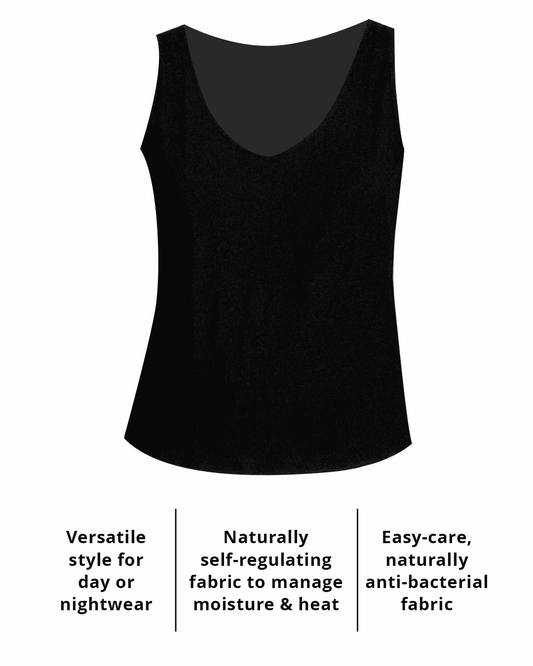
What Not To Sleep In If You Have Night Sweats
Partager
This post was updated on October 23, 2025 to include tips on how to evaluate fabrics that help, not hinder, your sleep.
Fabric is fabric, right? I mean, you either like the feel of it against your skin, or you don't, but other than that, you don't really think about it too much. Until, that is, you suffer from night sweats or hot flashes, in which case, fabric takes on a whole new meaning. This is a post about how I inadvertently discovered the worst fabrics for night sweats. Read along, and I'll fill you in on what they are and why they're so awful for night sweats sufferers. Some of them will surprise you.
I had been suffering from menopause-related night sweats for well over a year when I finally accepted that they were not going away anytime soon. I had been sleeping in an old polyester nightgown and was flipping my covers on and off all night long. I was soaked and exhausted every morning, and over time, the sleep deprivation really took its toll.
I decided that if I was going to continue to have night sweats, I’d better find the right sleepwear to help keep me comfortable – at the very least dry, and ideally could manage the heat my body was throwing off every other minute. So, I figured the best fabric for my night sweats was cotton. After all, cotton’s a highly breathable, natural fabric. It would help me solve my hot and clammy problem. I bought a new cotton nightgown, and I was excited that that night I would finally sleep again. I went to bed and drifted off to dreamland…for about 4 minutes. Then, the same routine as I’d always gone through started again: covers on…covers off. All. Night. Long.
In the morning I woke up soggy and exhausted and very discouraged. I couldn’t figure out why my breathable, natural nightgown hadn’t kept me dry and comfortable. In fact, after a month of use, I noticed my new nightgown had permanent sweat stains around the chest and under the arms.
It was at that point that I realized that sleeping comfortably with night sweats might be a little more challenging than I had thought. I wondered, if cotton was terrible for night sweats, which other fabrics should I avoid and which ones would help me sleep better and wake up dry?
While I was doing my research, I used my own background writing about green building materials to help me evaluate certain claims that companies were making about their fabrics. I also dug into the technical research papers on fabrics and the tests they performed.
Naturally, the subject is way more complex than I initially thought. It turns out the heat-sweat-fabric interaction involves chemistry, physics and biology. In addition to fabrics made out of specific fibres (ie, cotton or polyester), it also depends on how tightly they're woven, or the thickness of the fibre. Further, some blends are fantastic for night sweats, while others are not so good.
As you’ll see below, there are also some surprising materials you might want to stay away from if you suffer from night sweats. Some are made from natural (animal or plant) sources, whereas those made from synthetic sources, such as polyester or nylon, might be okay in certain cases.
There is one final caveat – you can have the best sleepwear in the world, or no sleepwear at all, and still wake up hot and sweaty and have a terrible night’s sleep. Why? It has to do with your sheets, blankets, mattress cover and mattress. They all interact with your heat-producing body. If they are all well-aligned, you can sleep much more comfortably and may, possibly, be able to sleep through the night again. However, if you are using the wrong materials for those layers, you're probably waking up soaked and exhausted. But, that, my friend, is a whole, ‘nother kettle of fish that we’ll leave for another time.
Without further ado, here are some of the worst fabrics for night sweats you can sleep in.
Most Polyester, Nylon, Acrylic, Synthetic fabrics
There are a lot of sleepwear garments made of polyester because it is an inexpensive fabric. Because it is synthetic (petroleum-based), the fibres don't respond to heat and moisture changes produced by your body. You can think of polyester and other synthetic fabric like plastic fishing line. The fibre itself is incapable of responding to heat and sweat given off by your body. In fact, tightly woven or thicker polyester can feel and act like plastic food wrap - trapping heat and moisture next to you keeping you very uncomfortable all night long.
The one exception is a polyester garment that is specifically made to wick sweat and pull heat through the sleepwear and moderate your body temperature. The way these synthetic garments work is that they have been treated with some sort of coating to manage heat and sweat, and they are woven/knitted in a way that pulls the heat away from you. But for the most part, ordinary polyester sleepwear will trap all that heat and sweat next to you leaving you hot and clammy all night long. (You can read our post on why we don't and never will use polyester here.)
Cotton
You’ve already read about my own experience with cotton and if you’re suffering with night sweats, you may have used the same logic I did and invested in some cotton sleepwear. The reason it doesn’t work for night sweats is because cotton is highly absorbent but also doesn’t like letting go of the water. Generally, cotton products take much longer to dry than some other fibres.
When you have night sweats and you're wearing a cotton garment, all that sweat your body has produced to cool you down is now trapped in your sleepwear next to your skin. Your sheets and blankets/duvet are also preventing the moisture from going anywhere, making you feel hot and clammy all night long, completely wrecking any chance you had for a decent night's sleep.
In the outdoor community they have a saying: “Cotton is rotten.” As you heat up and cool down, cotton will cling to you and you will become chilled and wet.
Silk
Silk is a wonderful insulating fibre. About 30 years ago, maybe more (am I showing my age??), silk was introduced into long underwear for its insulating capabilities. If your body's internal thermostat is working well, then silk is a lovely fabric, but if your thermostat is wonky and telling your body that you need to cool down every other minute, you’re going to be trapping all that heat and sweat next to you. Silk not only insulates you from outside temperatures, it traps the heat and sweat produced by you making you very hot and uncomfortable.
Silk is also terrible at managing moisture. If you have a silk blouse or camisole or some nice lingerie, think about what happens to it when you sweat. The sweat you produce will degrade the sleepwear much faster than other fabrics.
Wool
Like silk, wool is a great insulator. But unlike silk, it is wonderful at managing moisture. In fact, in houses, wool is becoming a popular choice for insulation because it works well even when wet. So, you would think that it would be great for night sweats.
The problem with wool is that even though it manages moisture really well, keeping you dry, it also keeps all the heat that you generate next to your body. You wake up and have to cover-flip because you’re so hot.
What about Merino wool?
Merino wool is superfine, soft wool and many people with night sweats love it. It is still highly insulating, so if you love the idea of wearing wool at night, make sure you get summer-weight Merino wool sleepwear. Anything heavier and you'll probably find it too hot.

So… What Should You Sleep In Instead?
If you’ve been waking up drenched, tossing aside sheets, and wondering what you’re doing wrong — the answer isn’t just in the thermostat. It’s in your fabric.
Here’s the thing: not all natural or “cooling” fabrics behave the same way once the night sweats kick in. Some absorb and hold on to moisture while others trap heat under the surface polyester. The key is choosing fabrics that breathe, wick, and release moisture — all without making you feel clammy.
Read our post on the BEST fabrics to sleep in when you have night sweats for more details on fabrics that keep you dry and comfortable all night.
That’s where natural performance fabrics like hemp, linen, Tencel, and blends of hemp with organic cotton come in. They’re breathable by design, naturally antibacterial, and don’t rely on chemical finishes or synthetics to keep you cool. They work with your body’s temperature swings — not against them.
Why This Matters

When you’re managing night sweats, every small detail counts. Your body heat rises, your fabric traps it, you start to sweat — and suddenly you’re awake, uncomfortable, and exhausted before morning.
Choosing the right fabric means giving your body a chance to reset naturally through the night, without the clammy wakeups or 2 a.m. sleepwear or sheet changes.
That’s the difference between just coping with night sweats and actually sleeping through them.
Ready to Sleep Dry Tonight?
Start with what’s closest to your skin — your sleepwear.
Our Simone Nightgown and Vanessa PJ Set are made from a unique hemp–organic cotton blend that naturally regulates heat, wicks moisture quickly, and gets softer every time you wash it.
🌿 No synthetics. No chemical coatings. Just simple, natural comfort that lets you wake up refreshed.




